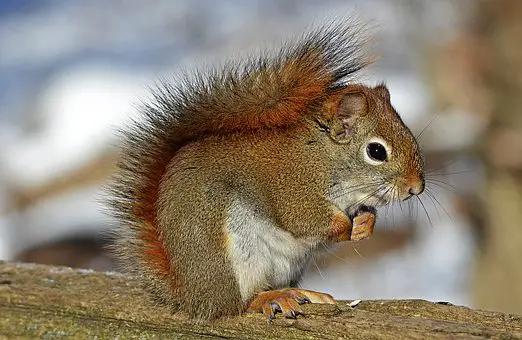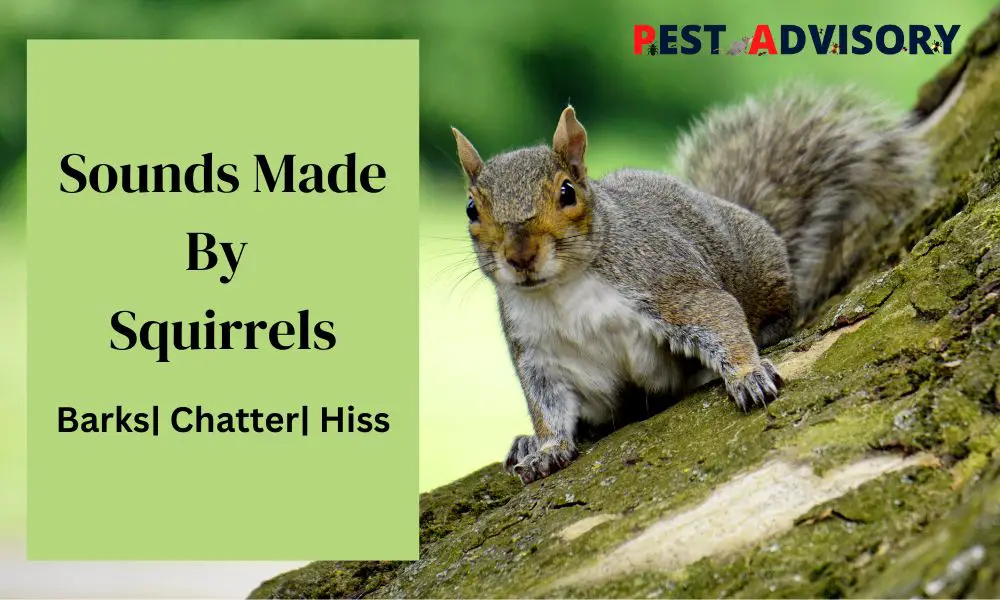Have you ever wondered why no one mimics the squirrel sound? I mean, people do an excellent mimicry of barks and roars and meows, but what’s up with those cute rodents in the local park?
Well, the reason is, there is no “the squirrel sound”. Squirrels use a variety of vocal adjustments to communicate with each other.
While they are not easily copied by humans, associating the sounds with the reasons for them is the first step in studying squirrel behavior. Also, if you know how to read squirrel sounds you can gauge the severity of suspected squirrel infestation in your homes.
Important Note: If you're tired of pests and want a reliable solution, then you should definitely consider seeking help from a professional pest control company. DIY solutions can be effective, but if you're dealing with a significant pest infestation, you don't want to rely solely on DIY methods. Pest control companies typically don't charge huge fees. You can fill out this form to receive free quotes from the top local pest control companies, and compare the quotes and see for yourself. Then, finally, your pest problems will be eliminated for good.
To learn more about squirrel vocals, stay with us till the end.
How Do Squirrels Make Sound?
Unlike most creatures around, if a squirrel produces any sound, it is not easily detectable by looking at them. We see a crow “cawing”, dogs barking, and cats “meowing”, but we rarely realize if a squirrel is screeching or rattling.
The reason is that they do not use their mouth to release the sounds. Their sounds are produced from deep within their chests and they modulate their breathing according to it.
If you notice a squirrel carefully for an extended period, you will understand how its breathing changes when they make particular sounds; for instance, if the squirrel is moaning you will see how its body constricts and expands to accommodate the fast-irregular breathing.
Variations of Sounds Made by Squirrels
Squirrels are more vocal compared to other species of rodents. They are small and cute and always running around, but if you sit still near some squirrel colony, you are bound to hear a variety of chattering noises. They might seem like they come from different animals, but most of them are squirrels’ vocal variations.
Sounds made by squirrels depend on their age, situation, and audience.
Some variations are:
- Rattles
- Screeches
- Kuk-Kuk
- Quaa
- Moans
- Seet bark
- Muk-Muk
- High pitched chirps
Purpose of Different Sounds of Squirrels
Alarm Calls
Squirrels are community-centric creatures. They believe if there is a danger to one, it speaks danger to all. In this context, we attempt to distinguish between the alarm calls made by them.
A study conducted by the University of Miami found that squirrels have very specific brands of alarm calls. According to the study, there are five potential threat stimuli that the squirrels perceive and give calls accordingly.
The alarm calls are:
Kuk-Kuk
his is like a shortened bark that serves more like a generic signal. This sound carries to a larger distance, almost like a broadband signal.
The squirrels use this as an alert for terrestrial, as well as aerial threats.
These are usually made by adult squirrels.
Quaa
This is a sort of extended bark that the squirrels generally use when they spot some terrestrial threats. Rarely these can also be alerts against aerial predators. These too are made by adult squirrels.
Moans
Squirrel moans sound like an extended squeak. These are sounds made when the threat is closer. It is like the last-ditch effort, to say that “people, scurry off. The threat is almost on top of us”.
These are very tone-based sounds that are sometimes extended, or repeated at regular intervals. It depends on the urgency of the situation. This is also released by adult squirrels.
Seet barks
These sounds are like the revving of a motorbike. It is reserved for warning against aerial predators like hawks and eagles.
If you hear these sounds, be rest assured there is not one but quite a few squirrels around.
Defending Territory
Squirrels are far from being calm creatures. They tend to get aggressive very fast. And they are extremely territorial. If a squirrel thinks that the other squirrel is encroaching upon its territory, a verbal war breaks out.
This is when squirrels let out rattles and screeches. Rattles are a long series of rapid knocks. It sounds like the hand prayer wheels found in Buddhist monasteries.
Screeches are merely shriller and longer versions of rattles.
Even when humans go near their nests, where their young rest, these sounds are made.
If you hear such sounds when near the attics or terraces, it confirms the presence of squirrels.

Mating Calls
Squirrels are polyandrous and polygamous creatures. That means male and female squirrels can have more than one partner.
To show that they are interested in mating the females, the male squirrel lets out a Muk-Muk sound. This sounds like a quick short string of stifled sneezes.
Sometimes baby squirrels can also produce this sound to signal their hunger.
Thus if you hear these sounds it speaks of impending doom. Because this means the squirrel family will or has already increased in your home or yards.
Contact Calls
Squirrels use contact calls to maintain social cohesion within their groups. These calls are soft and low-pitched, and they may be used to locate other squirrels in the area or to signal that everything is safe.
Distress Calls
When a squirrel is injured or in danger, it may emit a distress call to alert other squirrels in the area. These calls are often high-pitched and repeated rapidly, and they may continue until the squirrel is rescued or the danger has passed.
High Chirping and Chattering
High-pitched chirping is like a very shrill squeak heard in rapid succession. These are made by adults as well as baby squirrels.
This is them communicating among themselves. And it is only while chirping you can see a squirrel using its mouth to release the sound.
These can often be confused with bird chirps.
The chattering sound is like the rotating chains of a bicycle. This is the most commonly heard squirrel sound.
Aggressive Sounds made by Squirrels
The sounds that hint that squirrels can attack you and you need to avoid them are:
Barks
Squirrels may emit a series of sharp, loud barks when they feel threatened or are in conflict with another squirrel. These barks are often accompanied by physical displays such as tail flicking and charging.
Growls
Squirrels may emit low-pitched growls when they are in close proximity to another squirrel and are feeling threatened. Growls may be accompanied by other aggressive behaviors such as teeth chattering or lunging.
Hisses
Squirrels may emit a hissing sound when they are feeling threatened or are in conflict with another squirrel. Hisses are often accompanied by physical displays such as arched backs and fluffed tails.
Differences in Squirrel Sounds between Species
There are several different species of squirrels, and each has its own unique set of vocalizations and sounds. Here are some examples of differences in squirrel sounds between species:
Eastern Gray Squirrel
The Eastern Gray Squirrel is one of the most common squirrel species in North America. They emit a variety of sounds, including barks, chatters, and squeaks. Their alarm calls are a series of high-pitched barks, while their mating calls are a series of soft, low-pitched coos.
Red Squirrel
The Red Squirrel is smaller than the Eastern Gray Squirrel and is typically found in coniferous forests. They emit a variety of sounds, including barks, chatters, and trills. Their alarm calls are a rapid series of high-pitched chirps, while their mating calls are a series of rapid, high-pitched squeaks.

Fox Squirrel
The Fox Squirrel is larger than the Eastern Gray Squirrel and is typically found in wooded areas. They emit a variety of sounds, including barks, chatters, and moans. Their alarm calls are a series of loud, high-pitched barks, while their mating calls are a series of low-pitched grunts.
Flying Squirrel
The Flying Squirrel is smaller than the Eastern Gray Squirrel and is typically found in wooded areas. They emit a variety of sounds, including barks, chatters, and trills. Their alarm calls are a series of rapid, high-pitched chirps, while their mating calls are a series of low-pitched trills.
Ways in which Squirrel Sounds Contribute to the Ecology
Squirrel sounds play an important role in the ecology of forests and other habitats where they live.
Communication
Squirrels use vocalizations to communicate with each other about a range of things, including food sources, potential threats, and mating. By communicating with each other, squirrels can coordinate their behavior and avoid potential dangers.
Predator detection
Squirrels have a keen sense of hearing and can detect potential predators from a distance. They may use alarm calls to alert other squirrels in the area to the presence of a predator, allowing them to take evasive action.
Territory marking
Squirrels use vocalizations to mark their territory and signal to other squirrels that they are present. This can help to prevent conflict and competition between squirrels in the same area.
Reproduction
Squirrel vocalizations also play a role in reproduction. During the breeding season, males may use vocalizations to attract females, while females may use vocalizations to signal their receptivity to mating.
Seed dispersal
Some squirrel species, such as the gray squirrel, play an important role in seed dispersal. They may bury nuts and other food sources in the ground, which can lead to the germination and growth of new plants.
Overall, squirrel sounds contribute to the complex ecology of forests and other habitats where they live.
Final Words
So these are some of the most commonly heard sounds by squirrels. While other rodents tend to be quite silent, squirrels’ trademark rattling is a dead giveaway of their presence.
If you hear these sounds in the house or garden quite often, it means you have a squirrel infestation. Try out home remedies like peppermint oil and the filling of gaps. If that fails you should call in professional pest control. But do not let it go unacknowledged because squirrels can cause much damage.
Hope this article was helpful! If you suspect squirrel infestation, be super perceptive, keep alert about these sounds, and take action immediately.

